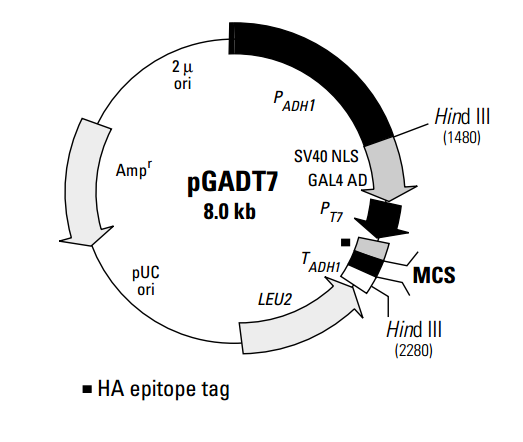pGADT7 载体
| 质粒类型: | 酵母双杂交系统 |
|---|---|
| 启动子: | ADH1 |
| 载体大小: | 8.0kb |
| 载体标签: | HA |
| 载体抗性: | Ampicillin (氨苄青霉素) |
pGADT7 AD is a yeast expression vector that is designed to express a protein of interest fused to a GAL4 activation domain (AD; amino acids 768–881). Transcription of the GAL4 AD fusion is driven by the constitutively active ADH1 promoter (PADH1), and is terminated at the ADH1 transcription termination signal (TADH1). The GAL4 AD fusion contains an N-terminal SV40 nuclear localization signal (SV40 NLS; 1) that targets the protein to the yeast nucleus, and a hemagglutinin epitope tag (HA Tag), located between the GAL4 AD and the protein of interest, that allows the protein to be easily detected with HA-tag antibodies.
The T7 promoter (PT7), located just upstream of the HA tag sequence, allows in vitro transcription and translation of the HA-tagged protein of interest (without the GAL4 AD and the SV40 NLS). pGADT7 AD replicates autonomously in both E. coli and S. cerevisiae from the pUC and 2 μ ori, respectively. The vector also contains an ampicillin resistance gene (Ampr) for selection in E. coli and a LEU2 nutritional marker for selection in yeast.
载体应用
pGADT7 AD is the AD Cloning Vector provided in Clontech's Matchmaker™ Gold Yeast One- and Two-Hybrid Screening Systems (Cat. Nos. 630491 and 630489, respectively). The vector allows the generation of GAL4 AD fusion proteins from either a gene of interest or a cDNA library. Important: Genes must be cloned into the MCS so that they are in-frame with the GAL4 AD and HA tag coding sequences. The vector can also be used as a negative "prey" control for the One-Hybrid System.
GAL4 AD/HA-tagged fusion proteins expressed by the vector can be detected with either our GAL4 AD Monoclonal Antibody (Cat. No. 630402) or our HA-Tag Polyclonal Antibody (Cat. No. 631207). Note: In vitro transcription/translation from the T7 promoter, located between the GAL4 AD and HA tag sequences, produces an HA-tagged protein that lacks the GAL4 AD. Such proteins can be detected by the HA-Tag Polyclonal Antibody, but not the GAL4 AD Monoclonal Antibody.


